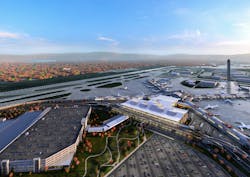The images of empty airports that we have seen in recent weeks are especially dreary. Border closures, travel restrictions and flight cancelations all to avoid infection from COVID-19 virus have led to the suspension of more than half the passenger traffic, according to Airport Council International (ACI). Forty-five percent of the destinations worldwide have totally or partially closed their borders for tourists and 30% have totally or partially suspended international flights. The International Air Transport Association (IATA) foresees a dramatic revenue loss for the aviation industry of more than $325 million. The pain doesn’t stop there. More than 25 million jobs worldwide will be affected either directly or indirectly by the virus.
The air transport industry faces its worst crisis since its inception. However, we can’t abandon ourselves and lead with pessimism. We have the opportunity to improve a model that has, until this point, been in a slow but constant evolution. Since the creation of the first airport structures and up until the current fourth generation of commercial airports, these enormous spaces have found passengers hugging those they love for a farewell or welcome; these spaces have been the “door” to their trips, spurring discovery and wonderment. Airports have always responded to the challenges of our unexpected reality. We saw it after Sept. 11, 2001, and we will see it again – even though the challenge this time is far more complex now.
‘Fifth-Generation’ Airport
Approximately every 30 years, a new generation of airport infrastructure appears. The next generation, the fifth generation, must break through, driven by current, public health, circumstances and technological innovation. Now is the moment to strike with safe, sleek and efficient concepts. However, there is no formula for designing an airport – no algebraic equation that solves all the variables of this great challenge, which includes managing a pandemic. An airport often informs a traveler’s first and last impression of a city, region or even a country. It must mirror its community. It must provide for a positive and memorable experience at a facility that is, in the best of times, busy, crowded and stressful.
Airports reflect what is going on in the world and, in fact, they manifest our greatest challenges. From providing for accessibility, to protecting against terrorism and responding to climate change, airports must answer society’s changing demands in real time. Now, amid a pandemic, architecture and design must do even more: They must balance the feeling of freedom of movement with the fear of uncertainty. They must also contribute to the survival of a vital industry that generates activity, wealth and cultural exchange.
Solution: ‘Flexibility’
How can airport design manage uncertainty and ensure security when the threat we are facing is “global and invisible,” and directly related to our hyperconnected way of life? How can infection be avoided in spaces/buildings that “move” a great amount of people?
The solution lies in “flexibility,” or maximizing an airport´s square footage to include and implement the new visible and invisible security actions while ensuring social distancing and cleaning. Space will be key.
The airport of the future is being designed now. What we imagined as a possibility is now an imperative in this new reality. Technology will no doubt play a main role – however, it will have consequences in different areas, namely privacy.
Introducing New Technologies
To reduce physical contact and avoid congregation, certain processes that, until now, occurred within the airport, will soon be completed “in advance.” With mobile apps, travelers will be able to do their check-in at home, in the hotel or on the way to the airport… And luggage will have an electronic labeling system which will be paper-free.
Temperature control tests will be implemented at airport entrances or in the parking areas, which will turn into registration and customer service areas. This will input another control measure prior to airport entry.
Electronic identification and sanitary “passports” will be electronically read without passengers rummaging through bags and pockets. Artificial intelligence and big data will allow security controls to be equipped with facial recognition and electronic passport screening. Again, these steps will be completed prior to passenger entry into the terminal.
Materials are going to change, too. The use of new photocatalytic devices based on antibacterial, antiviral and “autocleaning” material, such as titanium dioxide, silver or copper, in high-use areas will become the norm. Furniture, wayfinding and other contact-heavy elements of the space, think -elevator buttons, door handles, railings, etc., will be redesigned and rearranged to adapt to the new “contactless” reality. The spaces will also demand strict, long-lasting cleaning controls, and regimen will need to drastically increase, eliminating pathogen collection on various surfaces. These practices will become permanent hygienic protocols.
Eliminating Traveler Stress
In the wake of COVID-19, we will see the birth of new technologies. But we will also see how architecture increasingly utilizes natural light and ventilation. Both materials and other “analogic” methods will intuitively aid a user’s orientation and wayfinding within the terminal. They will also yield a reduction in energy consumption and also “humanize” these spaces. A stress-free experience will be pivotal in an area where both visible and invisible controls guarantee security. This comes as the fifth-generation airport discretely identifies, verifies and collects users’ digital information in order to maintain public health standards and uphold safety measures.
We must, again, plan for flexibility, a concept which sounds simple but is far more complex to implement.
How can design balance functional and security purposes while providing an environment that reduces stress and anxiety?
We foresee broadening uses of the airports to include open space as well as a “taste of the outdoors” and pavilion-like areas with ceilings allowing exposure to sunlight. Even spaces with long, dreary hallways can be transformed into culture centers reflecting a city’s history or geographic strengths, bathed in natural light.
Today’s ‘Cathedrals’
Airports are the cathedral of the 21st century. We all “inhabit” them in one way or another, and they forge relationships – with locations and people. In the best of times, millions of people step into airports every day. They are essential economic engines, as well as the largest centers of connectivity. This is the reason why I have devoted my life and career to the design of more than 10 airports worldwide. At our firm, luis vidal + architects, flexible, sustainable design is “built into our DNA.” Just like the airports’ host cities, we strive to connect people. This is why, as an industry, we need to work quickly, efficiently and in a coordinated way to ensure air travel comfortably outlives COVID-19.
To be clear, a sustainable airport of the future will be safe, recognizable, resourceful, cozy, sleek, dynamic and forward-thinking. But above all, it will be flexible to accommodate rapidly evolving challenges, no matter how difficult they are.
Perhaps most importantly, following this pandemic, we will learn how to build a safer future. As inherently social beings, this will help us develop and overcome. Humans have always had a need to travel, explore and discover – and then to return home safely to those we love. Our duty, as architects, is to make the journey memorable, iconic and safe, whatever the scenario may be.
Luis Vidal is the president and founding partner of luis vidal + architects, an international practice with offices in Spain, the U.K., Chile, the Dominican Republic and the U.S. Vidal offers responsible and quality designs in response to the urban and social challenges of the day. Vidal has received international recognition for implementing challenging ideas on large-scale, complex buildings such as airports, hospitals, office buildings, museums, university campuses and more. Vidal’s philosophy relies on improving quality of life through design. Notable projects include Heathrow’s award-winning Terminal 2 and several international airports in major U.S. cities including Pittsburgh, Boston, Dallas and Denver.Hear more from Luis and his thought on the future of airport design in a recent episode of the AviationPros podcast. www.AviationPros.com/21143342
About the Author

Luis Vidal
President and Founding Partner
Luis Vidal is the president and founding partner of Luis Vidal + Architects, a Madrid-based architecture practice with offices in Spain, the U.K., Chile, the Dominican Republic, and the U.S. Vidal offers responsible and quality designs in response to the urban and social challenges of the day. Notable projects include Heathrow’s award-winning Terminal 2 and several international airports in major U.S. cities, including Pittsburgh, Boston, Dallas and Denver.
